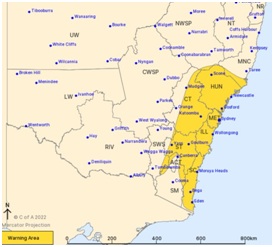

9th March 2022 (6 Topics)
Context
Australia to declare east coast floods a national emergency.
About
About Australia floods 2022:
- Sydney, Australia's most populous city, bracing for more rain after being drenched by heavy downpours over the past week.
- A wild weather system that dumped more than a year's worth of rainfall over a week in southern Queensland and northern New South Wales (NSW).
- It has brought widespread destruction, leaving thousands of people in the states displaced and sweeping away property, livestock and roads.
- Thousands of residents in Sydney’s south-west were ordered to evacuate overnight as heavy rain swelled rivers.
- Australia's east coast summer has been dominated by the La Nina weather phenomenon, typically associated with greater rainfall, with most rivers at near capacity even before the latest drenching.
- Sydney has received nearly 900 mm (35 inches) of rain so far in 2022, or about 80% of its annual rainfall, official data showed, the wettest start to a year since records began.

|
Rain:
Torrential rain:
Flood:
Flash flood:
|

